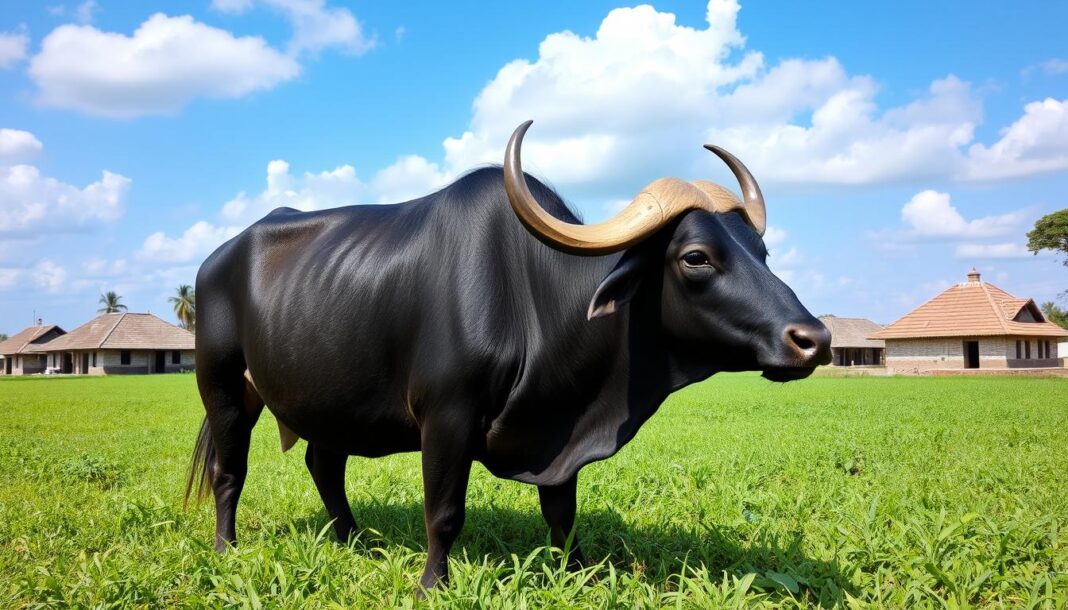As the sun sets over the Himalayas, I feel wonder and respect for Gojri buffaloes. These amazing animals are key to the Gujjar community’s dairy success. They make some of India’s most wanted milk and dairy products.
India is home to over half of the world’s buffaloes. The Gojri buffalo, a special riverine breed, is vital to India’s dairy success. These animals are great at living in the sub-Himalayan region’s hills and valleys. They show the deep bond between the Gujjar people and nature.
We’ll explore the world of Gojri buffalo breeding. We’ll learn about their history, cultural importance, and special care. The Gujjar community’s traditions have made their dairy operations strong. They ensure the breed’s survival and India’s rich agricultural heritage.
Understanding the Gojri Buffalo Heritage
The Gojri buffalo is a special riverine breed with a deep history in Himachal Pradesh and Punjab, India. These animals are tough and fit well in the rugged sub-Himalayan areas. They are closely tied to the Gujjar community, a nomadic group.
Learning about the Gojri buffalo’s origins and where it’s found helps us understand its lasting impact.
Origin and Historical Significance
The Gojri buffalo comes from the sub-Himalayan areas. It has a unique 50 chromosomes, linking it to the riverine buffalo family. For many years, it has been a key part of the Gujjar community’s life.
The Gujjars, known for their nomadic ways and animal care skills, have helped keep the Gojri buffalo alive.
Geographic Distribution in India
The Gojri buffalo mainly lives in the Himalayan and sub-Himalayan areas. This includes parts of Jammu & Kashmir, Himachal Pradesh, and Uttarakhand. Its spread follows the Gujjar community’s migrations and grazing habits.
This is because the Gujjars move through these mountains with their nili-ravi and murrah buffalo.
Cultural Importance in Gujjar Community
The Gojri buffalo is very important to the Gujjar community. It’s not just a way to make a living but is part of their identity and traditions. The Gujjars’ way of life centers around their buffalo herds.
These herds are key for their dairy, rich milk, and overall well-being.
Physical Characteristics and Breed Standards
The Gojri water buffalo is a top choice in the dairy world. It stands out because of its unique looks and standards. These buffaloes have a black to light brown coat with thick brown hair. Their horns are special, and their muscles help them move easily in the hills.
Gojri buffaloes are great at handling tough mountain weather. They have a special skin layer that keeps water and harmful stuff out. This makes them very strong.
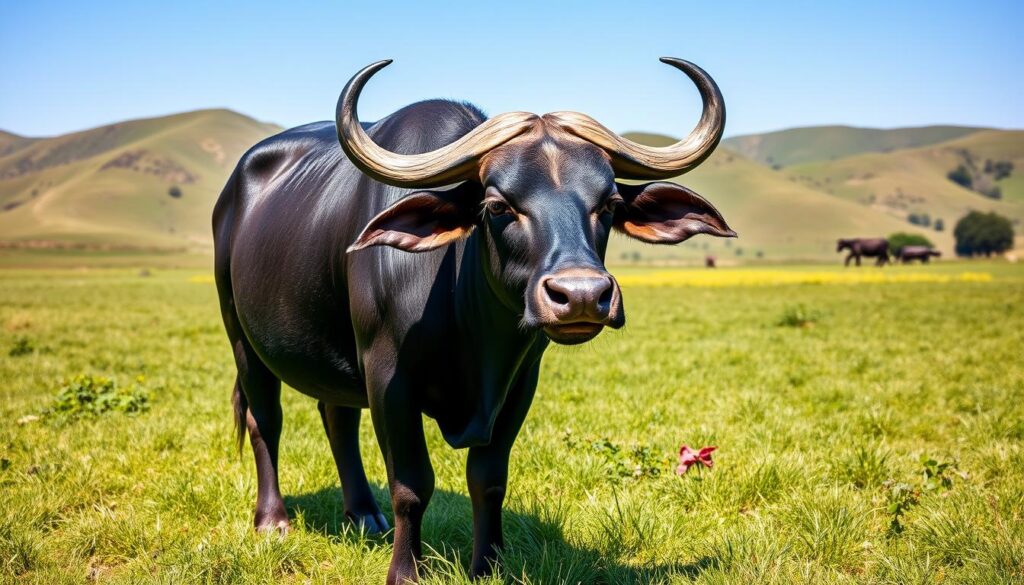
| Breed Characteristic | Description |
|---|---|
| Body Color | Black to light brown |
| Coat | Thick layer of brown hair |
| Horn Orientation | Distinct horn configuration |
| Body Build | Muscular, suitable for hilly terrain |
| Skin Feature | Greasy sebum layer for protection |
The Gojri buffalo has its own set of breed standards. These include the shape and size of the udder and tail. These standards are key in water buffalo husbandry and dairy production. They help keep the breed’s special traits alive.
Gojri Buffalo Breeding: Essential Practices and Techniques
Breeding Gojri buffaloes aims to keep their special traits while boosting productivity. Selective breeding methods help increase milk yield and adaptability. Genetic improvement focuses on spreading traits like high milk fat and disease resistance.
Selective Breeding Methods
Selective breeding picks top animals with the traits you want. This means choosing for high milk, good body shape, and resistance to diseases. By managing breeding well, farmers can make their herd better and meet dairy demand.
Genetic Improvement Strategies
Genetic improvement in Gojri buffalo breeding aims to boost good genes. Scientists study genes like SCD1, DGAT1, and STAT1 to improve milk. Knowing the genetics helps breeders target improvements in desirable traits.
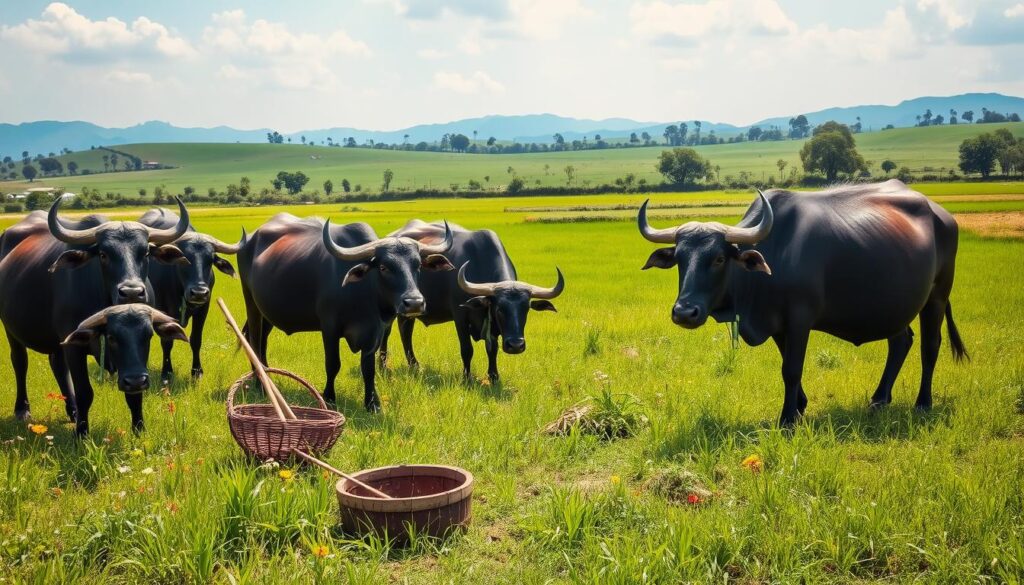
Reproduction Management
- Gojri buffalo breeding uses natural mating and artificial insemination.
- Natural mating keeps the breed’s genetic diversity and local adaptability.
- Selective breeding and artificial insemination bring in good traits from other breeds.
- Managing the breeding cycle, heat detection, and nutrition is key for better herd performance.
Traditional Management Systems
The Gojri buffaloes are managed by the Gujjar herders in a unique way. In summer, they move to high altitudes for better grazing. In winter, they return to the plains for more grazing.
The Gujjar community uses “kullas” for their buffaloes. These shelters are made of mud and special grasses. They protect the buffaloes and help use the natural environment well.
The Gujjar’s migratory system is good for the buffaloes. It makes them healthy and productive. This way of managing buffaloes is a big part of the region’s culture and farming.
| Characteristic | Gojri Buffalo | Murrah Buffalo | Nagpuri Buffalo |
|---|---|---|---|
| Origin | Jammu and Kashmir | Haryana | Maharashtra |
| Coat Color | Varied, from light to dark brown | Jet black | Dark brown to black |
| Milk Fat % | 7-8% | 7-8% | 6-7% |
| Milk Yield (liters/day) | 8-10 | 10-12 | 6-8 |
Nutrition and Fodder Requirements
Gojri buffaloes are tough and adapt well to the Himalayas. They need different foods at different times and places. They eat grasses and shrubs in the mountains, which are key for their health and milk.
Dietary Needs During Different Life Stages
Gojri buffaloes need a lot of protein, energy, and minerals when they’re making milk. Young ones need food rich in nutrients for growing. Pregnant and not milking buffaloes need food to keep them healthy and ready for more milk.
Grazing Patterns and Feed Management
Gojri buffaloes in India move with the seasons. They go up high in summer and come down in winter. Farmers make sure they eat a variety of plants all year to keep them healthy.
Water Requirements
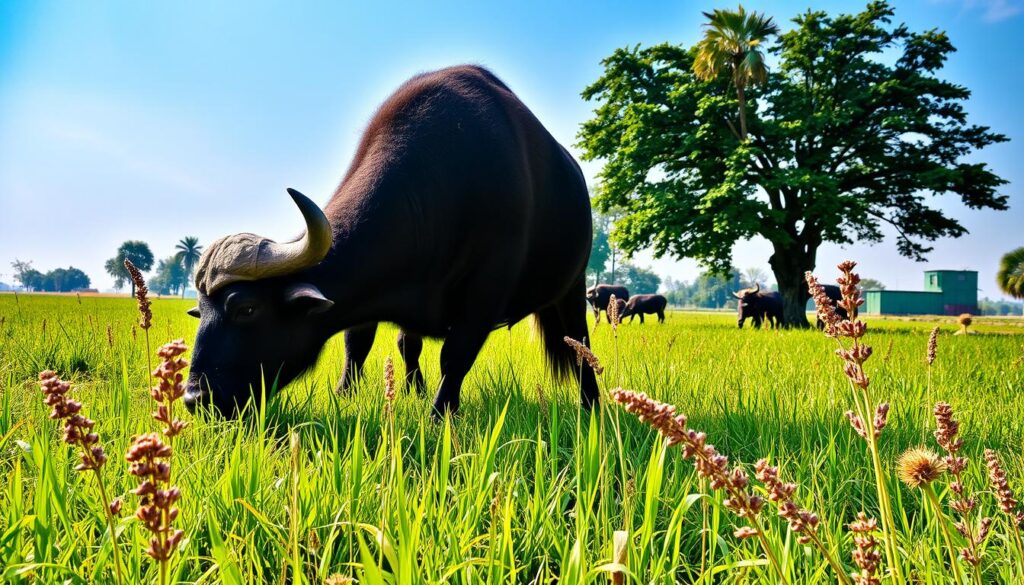
Water is very important for Gojri buffaloes, more so when they move. They need clean water to stay healthy and productive. Farmers plan their routes to make sure they have enough water.
| Nutrient Requirement | Lactating Buffaloes | Dry Buffaloes | Growing Calves |
|---|---|---|---|
| Crude Protein (CP) | 18-22% | 12-14% | 16-18% |
| Total Digestible Nutrients (TDN) | 70-72% | 60-62% | 65-68% |
| Calcium (Ca) | 0.8-1.0% | 0.6-0.8% | 0.8-1.0% |
| Phosphorus (P) | 0.5-0.6% | 0.4-0.5% | 0.5-0.6% |
Production Performance and Milk Yield
Gojri buffaloes are famous for their high-quality milk. It’s creamy and has a lot of fat. They produce a lot of milk, perfect for the traditional way of life they live in.
The amount of milk Gojri buffaloes make changes with the environment and how they are cared for. Their milk production is linked to their migration patterns. This affects how much milk they give out.
Even though we don’t have all the numbers, Gojri buffaloes are loved for their milk. It’s great for making ghee, butter, and curd. Their milk is key to the local dairy business, helping the Gujjar community.
| Milk Yield Characteristics | Gojri Buffaloes |
|---|---|
| Average Milk Yield (liters per day) | Data Unavailable |
| Average Lactation Period (days) | Data Unavailable |
| Milk Fat Content (%) | High |
| Suitability for Traditional Dairy Products | Excellent |

Gojri buffaloes show how well they adapt to their environment. They have a special bond with the traditional way of life. As we learn more, we’ll see how valuable they are for India’s dairy industry.
Healthcare and Disease Management
The care of water buffalo husbandry in the Gojri buffalo population focuses on their unique health challenges. These water buffalo face issues like parasitic infestations, foot problems from long walks, and reproductive disorders.
Common Health Issues
- Parasitic infestations: Gojri buffaloes often get internal and external parasites. These can harm their health and reduce their productivity.
- Foot problems: Their long walks can cause hoof issues like lameness and foot rot. Regular hoof care is needed.
- Reproductive disorders: They may face reproductive problems like delayed puberty, poor fertility, and calving difficulties.
Preventive Care Measures
The Gujjar community uses both modern and traditional methods to keep their water buffalo healthy. They deworm, care for hooves, and vaccinate regularly. They also use traditional herbal remedies for minor illnesses.
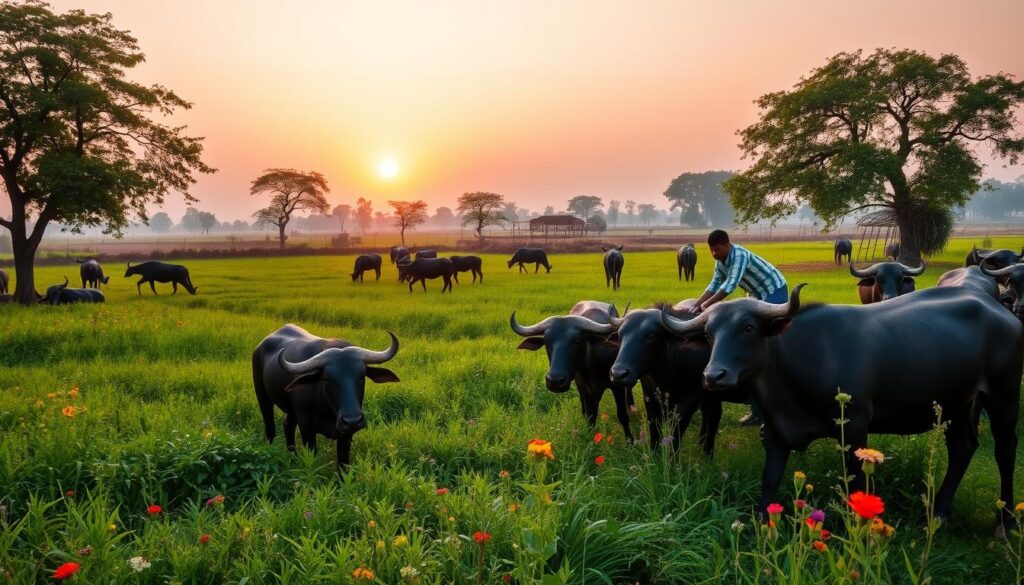
| Preventive Care Measure | Objective |
|---|---|
| Deworming | Reduce the impact of internal parasitic infestations |
| Hoof Care | Maintain healthy hooves and prevent foot-related issues |
| Vaccination | Protect against common infectious diseases |
| Traditional Herbal Remedies | Treat minor ailments and complement modern veterinary practices |
By using these preventive measures, the Gujjar community works to keep their water buffalo healthy and productive. This ensures the long-term management of this valuable resource.
Economic Impact and Market Value
The Gojri buffalo is key to the local economy in India’s sub-Himalayan regions. It’s a main source of income for the Gujjar community. These buffaloes give a steady milk supply, with ghee being a top product that sells well.
Gojri buffaloes do more than just provide milk. They also boost cultural tourism and help keep the environment balanced. People come to see the traditional way of life and the buffalo rearing practices.
A recent project in Himachal Pradesh started in September 2022. It aims to map the pastoral communities and their grazing paths. This is the first step towards a big effort to save these valuable animals.
Research is also underway to understand the Gojri buffalo better. A study looked at 385 water buffalo, including 123 Gojri ones. It found out how adaptable the breed is and how to improve it through breeding.
As more people value Gojri buffalo products and their cultural importance, the economic outlook is good. Conservation efforts will help the Gojri buffalo become even more valuable in India’s dairy market.
Conclusion
The Gojri buffalo breed is a special mix of old traditions and new dairy needs in India. It’s known for its great adaptability, high-quality milk, and deep cultural value. This makes it a key player in sustainable dairy farming in the sub-Himalayan area.
It’s important to keep working on saving, improving, and mixing old wisdom with new methods for the Gojri buffalo. With 56% of the world’s buffalo, India’s success in managing this breed can greatly help its dairy industry.
India needs to keep researching and sharing data to understand the Gojri buffalo’s genetic strengths. This will help in making better breeding plans and saving important genetic material. By using its buffalo resources wisely, India can grow its dairy sector and honor the Gojri buffalo’s cultural importance.

